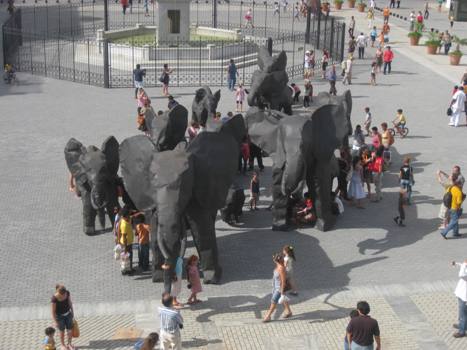Centro de Arte Contemporáneo Wilfredo Lam,
Mar 27, 2009 - Apr 30, 2009
La Habana Vieja, Cuba
10th Havana Biennial
by Pily Estrada and Christian León
(Resistance), Globalization and Art
The Paradoxes of the 10th Havana Biennial The 10th Havana Biennial, the theme of which was “Integration and Resistance in the Global Era”, was a good opportunity to assess the 25th anniversary of one of the most emblematic art institutions in the Third World. Despite the enthusiasm of the organizers, the years have not gone by in vain and rather than maturity, the present has brought uncertainties and contradictions. First edition, 1984: the Biennial is born with a clear-cut geopolitical mission. Its aim was to create an event designed to decentralize the underpinnings of the discourse and institutionalism of art created in the power centers of the First World. The Biennial sought to foster exchanges between Latin America, Africa and Asia without going through the filter of Eurocentrism. Tenth edition, 2009: the world has changed. Due to the effects of migration, the mass media and globalization, the third world position has seen its foundations erode; its discourse on identity has been overtaken by hybridization and transculturalization; multiculturalism has become an institutionalized discourse; the periphery’s major art institutions are becoming more and more incorporated into the globalized art system. New practices, struggles and symbolic demands are invading the field of art and questioning the existing institutional approach. Alternative and emergent art is no longer in Havana. The Havana Biennial gradually restricted its geopolitical criticism to a global design that vindicates the materiality of the artwork, the figure of the author and the exhibition format. It grew in size, prestige and dimension. It turned into a mega show where established art converges under an institutional framework that perpetuates what it once sought to contest. Nelo Vilar, one of the speakers at the Art Theory Event, rightly pointed out that the word “resistance” had fallen off the Biennial’s slogan. Viewed from that perspective, it is easier to understand the emphasis on growth numbers. This Biennial consisted of more than 100 exhibitions housed throughout the city, in which 300 artists from 45 countries took part. The official pavilions were characterized by a standardized curatorial and museographic line that left little room for breaking away, innovating or taking risks. The most meaningful curatorial and artistic approaches were to be found in the collateral shows, among them El maíz es nuestra vida [Corn is our Life], Latitudes: Tierras del Mundo [Lands of the World], Tales from the New World, Punto de Encuentro [Meeting Point], China: arte contemporáneo revista ¨[China: contemporary art review], Chelsea visita La Habana [Chelsea visits Havana], and Resistencia y libertad [Resistance and Freedom], although with varying degrees of consistency. Among the pieces that caused the most expectation were the performances by Guillermo Gómez Peña, Tania Bruguera and Cai Guo Quiang. The latter, a well-known Chinese artist, burned a boat made by the Cuban artist Kcho through a rather austere chain of fireworks. A 10 second performance that left the impressive crowd at the Plaza San Francisco with a general feeling of “was that all?” The Biennial’s Art Theory Event, featuring well-known figures such as Nicolás Bourriaud, José Luis Brea, Nelly Richard, Julia Herzberg, and Michael La Chance, among others, deserves special mention. Of the individual exhibitions, those by Carlos Garaicoa, Paolo Bruscky, León Ferrari, René Francisco and the recently deceased Shigeo Fukuda were worthy of note. Among the enormous number of works exhibited in the official pavilions, eight artists in particular, all with fairly long track records, caught our attention: Pipo Hernández and Paco Guillen from Spain, Yoan Capote, José Emilio Fuentes and Glenda León from Cuba, María Elvira Escallón of Colombia, the New Yo
|









